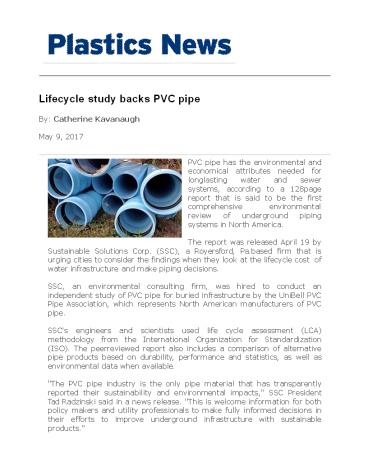Lifecycle study backs PVC pipe - PowerPoint PPT Presentation
Title:
Lifecycle study backs PVC pipe
Description:
PVC pipe has the environmental and economical attributes needed for longlasting water and sewer systems, according to a 128page report that is said to be the first comprehensive environmental review of underground piping systems in North America. – PowerPoint PPT presentation
Number of Views:31
Title: Lifecycle study backs PVC pipe
1
Lifecycle study backs PVC pipe By Catherine
Kavanaugh May 9, 2017 PVC pipe has the
environmental and economical attributes needed
for longlasting water and sewer systems,
according to a 128page report that is said to
be the first comprehensive environmental review
of underground piping systems in North
America. The report was released April 19 by
Sustainable Solutions Corp. (SSC), a Royersford,
Pa.based firm that is urging cities to consider
the findings when they look at the lifecycle
cost of water infrastructure and make piping
decisions. SSC, an environmental consulting
firm, was hired to conduct an independent study
of PVC pipe for buried infrastructure by the
UniBell PVC Pipe Association, which represents
North American manufacturers of PVC pipe. SSC's
engineers and scientists used life cycle
assessment (LCA) methodology from the
International Organization for Standardization
(ISO). The peerreviewed report also includes a
comparison of alternative pipe products based on
durability, performance and statistics, as well
as environmental data when available. "The PVC
pipe industry is the only pipe material that has
transparently reported their sustainability and
environmental impacts," SSC President Tad
Radzinski said in a news release. "This is
welcome information for both policy makers and
utility professionals to make fully informed
decisions in their efforts to improve
underground infrastructure with sustainable
products."
2
Radzinki served 10 years as a national expert on
waste minimization programs for the U.S.
Environmental Protection Agency before starting
SSC in 2011. He's a mechanical engineer with a
master's degree in water resources and
environmental engineering as well as an adjunct
professor at Villanova University and an active
member of the U.S. Green Building
Council. SSC's report is out as aging
infrastructure, pipe corrosion and water quality
issues are stirring debate about the best ways to
address 1 trillion of drinking water system
upgrades identified by the American Water Works
Association. The firm says its study evaluates
pipe infrastructure in the context of providing
sustainable water and sewer service over a
100year period with minimal risk of degrading
water quality while reducing operation
costs. Bruce Hollands, executive director of the
Dallasbased UniBell PVC Pipe Association, said
one of the main points he hopes decision makers
will consider is that the energy required to
pump water through PVC pipes over a 100year
design remains constant because the pipe walls
remain smooth. "This generates overall
lifecycle cost savings and a lower carbon
footprint compared to ductile iron and concrete
pipes that require more pumping energy over time
due to corrosion, leaks and internal
degradation," Hollands said in an
email. Hollands said that over its lifespan, PVC
pipe is less expensive "while maintaining
performance and reliable service levels,
protecting water quality and minimizing water
main breaks, water loss, infiltration and
pavement repairs." The report also says PVC pipe
does not emit or leach toxic substances when it
is manufactured or when it conveys water. And, it
says PVC pipe does not corrode internally or
externally or require chemical additives to
inhibit corrosion. Hollands said that's
important because corrosive soils affect about 75
percent of water utilities. "Ductile iron pipe
may last as little as 11 to 14 years in
moderately corrosive soils, requiring numerous
replacements over a 100year period," Hollands
said. "This increases the embodied environmental
energy impacts of iron pipe by up to nine times
compared to PVC." The report also gives a little
history about the pipe material. PVC was
discovered in the 1830s and introduced as a pipe
material in North America in 1951. The American
Society for Testing and Materials (ASTM) began
developing plastic pipe standards in 1955 and the
National
3
Sanitation Foundation, which became NSF
International, began certifying tinstabilized
PVC pipe for drinking water in 1956. An EPA
study found some gasketed (cemented with a
solvent) PVC pipes less than 2 inches in
diameter made in the United States prior to 1977
experienced vinyl chloride leaching. "However,
no instances of vinyl chloride leaching from any
North American PVC pipe manufacturer post1977
have ever been cited," the report says. Even
though it was funded by a trade group, Hollands
said the pipe study is a transparent review by
independent experts. "Do people pay for
university degrees?" he asked. "Yes, but they are
objective because they are obtained in a
transparent and independent fashion because the
institutions that issue them follow certain
rules, regulations and protocols. Same thing for
LCAs, which are governed by the ISO, peer
reviewed and then certified by the global health
organization NSF International, which is the
case for this report." The report is officially
called "Life Cycle Assessment of PVC Water and
Sewer Pipe and Comparative Sustainability
Analysis of Pipe Materials." Link
http//www.plasticsnews.com/article/20170509/NEWS/
170509889 Copyright 19952017 Crain
Communications Inc. All Rights Reserved.































